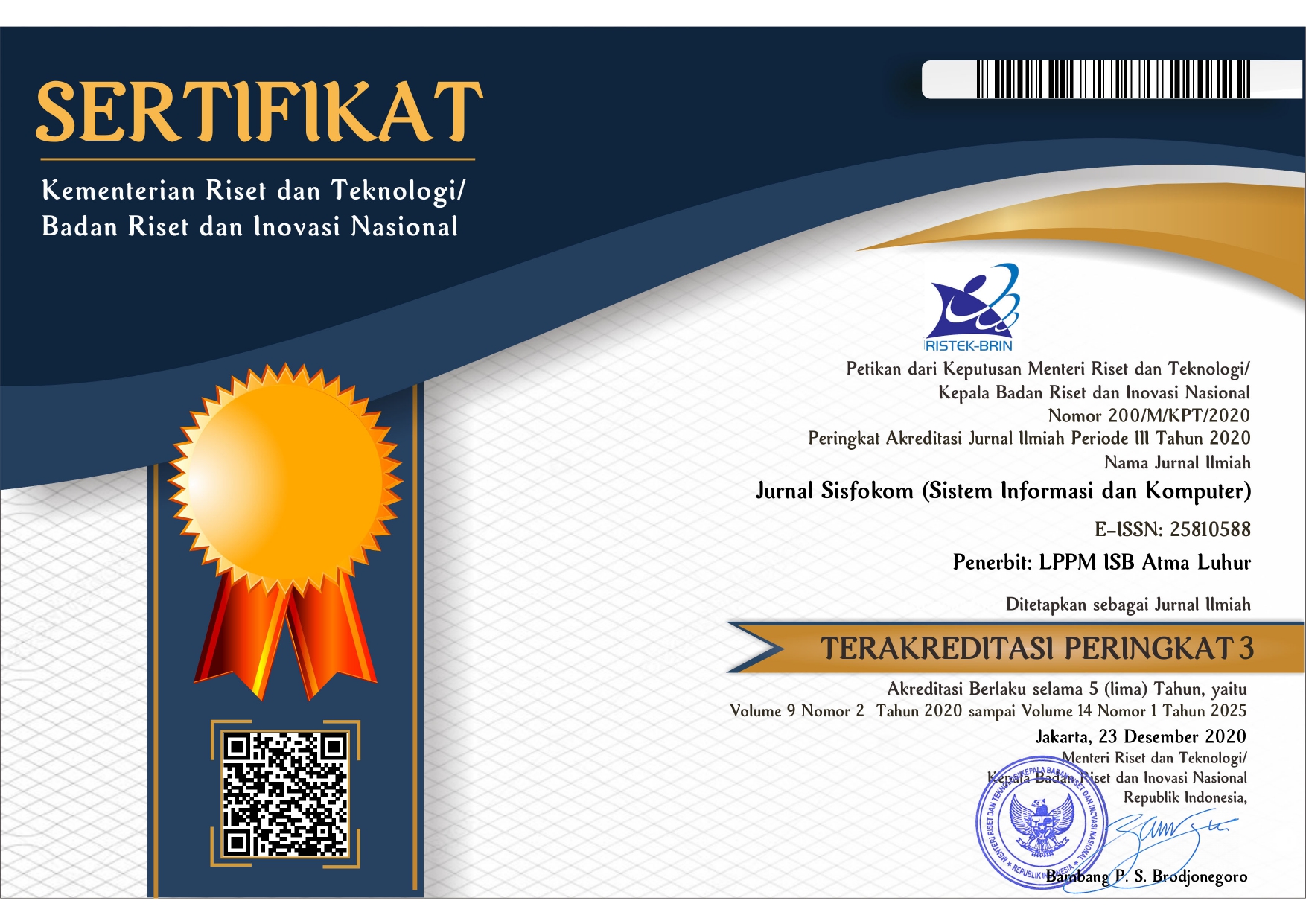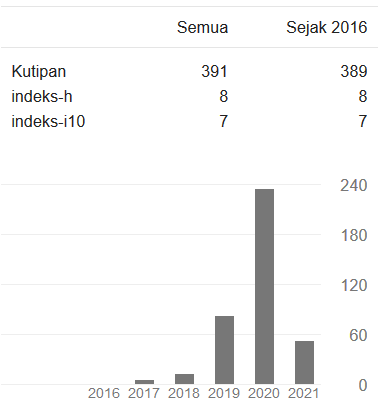Enhancing Review Processing in the Video Game Adaptation Domain through VADER and Rating-Based Labeling using SVM
DOI:
https://doi.org/10.32736/sisfokom.v14i3.2409Keywords:
SVM, Vader Lexicon, Sentiment Analysis, Video Game Adaptation, IMDb ReviewsAbstract
The adaptation of video games into films or television series has increasingly become a prominent trend in the entertainment sector, often eliciting diverse reactions from audiences.A prime example is The Last of Us, a video game adaptation series that generated substantial online discussions and sentiment, and serves as the specific case study in this research. Sentiment patterns found in audience reviews of The Last of Us on IMDb are analyzed using a domain-specific classification framework tailored to the language characteristics of entertainment media. A key issue addressed is the discrepancy between numerical ratings and the sentiment conveyed in review texts, which may lead to inconsistent labeling. The study employs a machine learning technique, Support Vector Machine (SVM), coupled with two distinct labeling methods: manual labeling based on IMDb ratings, and automatic labeling using the lexicon-driven VADER tool. A total of 2,017 English reviews of The Last of Us were gathered via web scraping from IMDb, followed by preprocessing, TF-IDF feature extraction, and hyperparameter optimization using RandomizedSearchCV. These results show that the SVM model trained on VADER-labeled data achieved an accuracy of 0.97, outperforming the model trained on manually labeled data at 0.79. Lexicon-based automatic labeling provides more consistent and reliable sentiment classification, particularly in specialized domains like video game adaptation reviews. Integrating VADER labeling with SVM enhances sentiment analysis effectiveness and offers practical value for media analytics, content creation, and audience insight research.References
R. R. Ilmi, F. Kurniawan, and S. Harini, “PREDIKSI RATING FILM IMDb MENGGUNAKAN DECISION TREE IMDb MOVIE RATING PREDICTION USING DECISION TREE,” Jurnal Teknologi Informasi dan Ilmu Komputer, vol. 10, no. 4, 2023, doi: 10.25126/jtiik.2023106615.
A. Saputra, S. Alfarisi, and R. N. Kholifah, “ADAPTATION ANALYSIS OF AMERICAN VIDEO GAMES MORTAL KOMBAT INTO FILM MORTAL KOMBAT REBOOT 2021,” Journal of Adaptation Studies, vol. 2, no. 2, 2022.
S. D. Wahyuni and R. H. Kusumodestoni, “Optimalisasi Algoritma Support Vector Machine (SVM) Dalam Klasifikasi Kejadian Data Stunting,” Bulletin of Information Technology (BIT), vol. 5, no. 2, pp. 56–64, 2024, doi: 10.47065/bit.v5i2.1247.
R. P. Kurnia and Y. A. Atma, “ANALISIS REKOMENDASI FILM DARI DATA IMDB MENGGUNAKAN PYTHON,” Journal Of Information System, Computer Science and Information Technology, vol. 3, no. 2, pp. 23–28, 2022.
L. M. Huizen, M. Basyier, and R. Artikel, “Meningkatkan kinerja SVM: Dampak berbagai teknik seleksi fitur pada akurasi prediksi,” AITI: Jurnal Teknologi Informasi, vol. 22, no. Maret, pp. 1–14, 2025.
M. H. Aufan, M. R. Handayani, A. B. Nurjanna, N. C. H. Wibowo, and K. Umam, “THE PERCEPTIONS OF SEMARANG FIVE STAR HOTEL TOURISTS WITH SUPPORT VECTOR MACHINE ON GOOGLE REVIEWS,” Jurnal Teknik Informatika (Jutif), vol. 5, no. 5, pp. 1241–1247, Oct. 2024, doi: 10.52436/1.jutif.2024.5.5.2025.
D. Abimanyu, E. Budianita, E. P. Cynthia, F. Yanto, and Yusra, “Analisis Sentimen Akun Twitter Apex Legends Menggunakan VADER,” Jurnal Nasional Komputasi dan Teknologi Informasi, vol. 5, no. 3, 2022.
S. Ernawati and R. Wati, “Evaluasi Performa Kernel SVM dalam Analisis Sentimen Review Aplikasi ChatGPT Menggunakan Hyperparameter dan VADER Lexicon,” 2024.
V. Nurcahyawati and Z. Mustaffa, “Vader Lexicon and Support Vector Machine Algorithm to Detect Customer Sentiment Orientation,” Journal of Information Systems Engineering and Business Intelligence, vol. 9, no. 1, 2023, doi: 10.20473/jisebi.9.1.109-119.
M. Taufiq Anwar and D. Riandhita Arief Permana, “Analisis Sentimen Masyarakat Indonesia Terhadap Produk Kendaraan Listrik Menggunakan VADER,” Jurnal Teknik Informatika dan Sistem Informasi, vol. 10, no. 1, pp. 783–792, 2023.
A. N. Zhafira, N. Afifah, S. A. Putri, V. Marhalatun, and D. I. S. S. Saputra, “ANALISIS SENTIMEN ULASAN FILM PADA DATASET IMDB MENGGUNAKAN ALGORITMA NAIVE BAYES INFO ARTIKEL,” vol. 4, no. 1Juni, pp. 373–383, 2025, doi: 10.70247/jumistik.v4i1.139.
N. J. Ramadhan, A. P. P. Putri, and D. A. Riyadi, “Eksplorasi Analisis Sentimen pada Rating Film IMDb: Pendekatan Perbandingan menggunakan Decision Tree dan Naive Bayes,” Journal Of Social Science Research, vol. 4.
F. Amaliah and I. K. D. Nuryana, “Perbandingan Akurasi Metode Lexicon Based Dan Naive Bayes Classifier Pada Analisis Sentimen Pendapat Masyarakat Terhadap Aplikasi Investasi Pada Media Twitter,” Journal of Informatics and Computer Science, vol. 03, 2022.
F. Alghifari and D. Juardi, “Penerapan Data Mining Pada Penerapan Data Mining Pada Penjualan Makanan Dan Minuman Menggunakan Metode Algoritma Naïve Bayes,” Jurnal Ilmiah Informatika, vol. 9, 2021.
M. U. Albab, Y. K. P., and M. N. Fawaiq, “Optimization of the Stemming Technique on Text Preprocessing President 3 Periods Topic,” Jurnal Transformatika, vol. 20, no. 2, pp. 1–12, Jan. 2023, doi: 10.26623/transformatika.v20i2.5374.
M. Azhari and Parjito, “Analisis Sentimen Opini Publik Program Makan Siang Gratis dengan Random Forest Pada Media,” Building of Informatics, Technology and Science (BITS), vol. 6, no. 3, pp. 1932–1942, Dec. 2024, doi: 10.47065/bits.v6i3.6423.
A. Daud, D. Irwanto, M. Said, M. Mubyl, and Mustamin, “Identification Of Chatbot Usage In Online Store Services Using Natural Language Processing Methods,” Advance Sustainable Science, Engineering and Technology, vol. 6, no. 2, Feb. 2024, doi: 10.26877/asset.v6i2.18309.
D. Khyani, S. BS, N. NM, D. BM, and M. YM, “An Interpretation of Lemmatization and Stemming in Natural Language Processing,” Journal of University of Shanghai for Science and Technology, vol. 22, 2020.
T. R. Salsabilla and N. Pratiwi, “Penerapan Support Vector Machine Untuk Analisis Sentimen pada X (Twitter) Mengenai Obat Penyebab Gagal Ginjal Akut pada Anak,” Jurnal Teknik Informatika dan Komputer, vol. 3, 2024.
D. Septiani and I. Isabela, “ANALISIS TERM FREQUENCY INVERSE DOCUMENT FREQUENCY (TF-IDF) DALAM TEMU KEMBALI INFORMASI PADA DOKUMEN TEKS,” SINTESIA: Jurnal Sistem dan Teknologi Informasi Indonesia, vol. 1, 2022.
T. A. E. Putri, T. Widiharih, and R. Santoso, “PENERAPAN TUNING HYPERPARAMETER RANDOMSEARCHCV PADA ADAPTIVE BOOSTING UNTUK PREDIKSI KELANGSUNGAN HIDUP PASIEN GAGAL JANTUNG,” Jurnal Gaussian, vol. 11, no. 3, pp. 397–406, Jan. 2023, doi: 10.14710/j.gauss.11.3.397-406.
P. L. Romadloni, B. A. Kusuma, and W. M. Baihaqi, “KOMPARASI METODE PEMBELAJARAN MESIN UNTUK IMPLEMENTASI PENGAMBILAN KEPUTUSAN DALAM MENENTUKAN PROMOSI JABATAN KARYAWAN,” Jurnal Mahasiswa Teknik Informatika, vol. 6, 2022.
Downloads
Published
Issue
Section
License
Copyright (c) 2025 Danita Divka Sajmira, Khothibul Umam, Maya Rini Handayani

This work is licensed under a Creative Commons Attribution 4.0 International License.
The copyright of the article that accepted for publication shall be assigned to Jurnal Sisfokom (Sistem Informasi dan Komputer) and LPPM ISB Atma Luhur as the publisher of the journal. Copyright includes the right to reproduce and deliver the article in all form and media, including reprints, photographs, microfilms, and any other similar reproductions, as well as translations.
Jurnal Sisfokom (Sistem Informasi dan Komputer), LPPM ISB Atma Luhur, and the Editors make every effort to ensure that no wrong or misleading data, opinions or statements be published in the journal. In any way, the contents of the articles and advertisements published in Jurnal Sisfokom (Sistem Informasi dan Komputer) are the sole and exclusive responsibility of their respective authors.
Jurnal Sisfokom (Sistem Informasi dan Komputer) has full publishing rights to the published articles. Authors are allowed to distribute articles that have been published by sharing the link or DOI of the article. Authors are allowed to use their articles for legal purposes deemed necessary without the written permission of the journal with the initial publication notification from the Jurnal Sisfokom (Sistem Informasi dan Komputer).
The Copyright Transfer Form can be downloaded [Copyright Transfer Form Jurnal Sisfokom (Sistem Informasi dan Komputer).
This agreement is to be signed by at least one of the authors who have obtained the assent of the co-author(s). After submission of this agreement signed by the corresponding author, changes of authorship or in the order of the authors listed will not be accepted. The copyright form should be signed originally, and send it to the Editorial in the form of scanned document to sisfokom@atmaluhur.ac.id.









